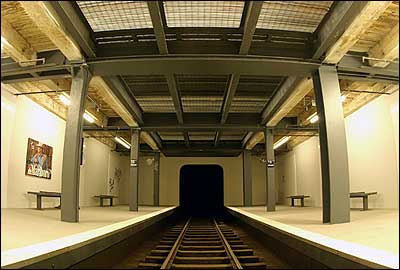I had a small piece in the Times today about artists' unrealized projects, which is really based on the interviewing work of the curator Hans Ulrich Obrist. Unlike architects' unbuilt projects, Obrist notes, which are published, debated, and considered critically important [look at the examples of Zaha Hadid or Thom Mayne, whose reputations were built largely on projects that weren't], artists' unrealized projects are invisible, almost a shame or a failure. Obrist is seeking to reconsider these projects.
These projects can feed, inform, or reveal the artistís process; or as Obrist puts it, they "show the artist negotiating with reality." And in some cases, the examining them has led to their renewal and fruition. Here are a few more unrealized projects I gleaned from Obrist's interviews (mostly from his most recent compilation, the 964-page Hans Ulrich Obrist Interviews, Volume 1) that didn't make it into the paper:
Maurizio Cattelan made a proposal in 1992 to distribute posters and flyers advertising a non-existent Nazi skinhead rally was actually rejected twice, by curators in the Swedish city of Sonsbeck in 1992, and again by a New York gallery organizing an exhibition on the theme of fear. [Actually three times if you count being cut from this article.] "It was a way to use information to spread fear: it was a psychological lab in real life," the artist recounted.
Chantal Akerman In 1997, "when there was some hope of peace in Israel," the artist explains, she wrote a script and scouted film locations in Syria, Lebanon and Jordan, but her producer was lukewarm to the project. "If I were to resume that project today, it would instead be about the impossibility of filming the Middle East."
Gabriel Orozco: Aguapracasa is a 1996 design for a house centered on a spherical pool, based on the 18th-century Jantar Mantar observatory complex in Jaipur, India. Since 1996, the artist found a place to build it, near the ocean in Mexico. "It is a house for me," Orozco says. "This one is a work in progress."
Yoko Ono: Sometimes a project is only partly realized. Though her 1999 sculpture Freight Train has been exhibited in museums, Ono's plan is "to hook it up to a train that goes to different countries in Europe, and for it to visit every city in Europe that way. Each time it stops in a city or a town, I want people to see the train and write about their memories of what happened."
Olafur Eliasson: "Yes, I think my life in general is a yet-unrealized project. This is, let's say, the bottom line." Of his interest in anti-gravity or his desire to make a botanical garden in a climate-controlled dome, the artist explains, "Ideas like this come and go every day," and they're all in "the big mixture-process-soup."
Roni Horn: "My future is my unrealized road. And there are always those footnotes I haven't gotten toólike dust collecting in the corner."
Art of The Undone [nyt]
not related: whatever about my piece, the interviews with the Star Wars and Herbie nerds totally rock.
[update: Sarah has good questions, which I answer as best I can, on Forward Retreat]
![]()

 Like some architecture critical version of Bobby Ewing. [Or is it Pamela? Whichever.] In this week's New Yorker, Paul Goldberger writes about the horrible dream he just had: Pataki and the Port Authority were railroading their 10mm sf uber alles program through at the WTC site, resulting in pointless, tenantless, characterless office buildings with marginal cultural facilities wedged in around their base, and a memorial that was little more than a front yard for some jingoistic, politicized ego-booster called the Freedom Tower.
Like some architecture critical version of Bobby Ewing. [Or is it Pamela? Whichever.] In this week's New Yorker, Paul Goldberger writes about the horrible dream he just had: Pataki and the Port Authority were railroading their 10mm sf uber alles program through at the WTC site, resulting in pointless, tenantless, characterless office buildings with marginal cultural facilities wedged in around their base, and a memorial that was little more than a front yard for some jingoistic, politicized ego-booster called the Freedom Tower. 

 Miss Representation dumps a scalding hot cup of realism in the Port Authority's lap by asking if their crown jewel--and the only thing the PA's obduracy hasn't botched so far--the Calatrava "transit hub", isn't just a crown roast instead.
Miss Representation dumps a scalding hot cup of realism in the Port Authority's lap by asking if their crown jewel--and the only thing the PA's obduracy hasn't botched so far--the Calatrava "transit hub", isn't just a crown roast instead.  Sherman Sam interviews the artist Hiroshi Sugimoto about his London show at Gagosian. Sugimoto's latest works, originally shown at the Fondation Cartier, are photographs of early 20th-century mathematical and mechanical study models from the collection of Tokyo University.
Sherman Sam interviews the artist Hiroshi Sugimoto about his London show at Gagosian. Sugimoto's latest works, originally shown at the Fondation Cartier, are photographs of early 20th-century mathematical and mechanical study models from the collection of Tokyo University.  Just as there's hardly an actor/waiter left in New York who hasn't made rent by doing a couple day's work on some Law & Order spin-off or other as an at-first tearful but increasingly suspecious relative or a neighbor who conveniently pins down the time of death by recounting what they were watching on TV, there's hardly a blogger left in the city who hasn't had to feign interest in Radar Magazine and cop to a fondness for the hard stuff while doing a "guest-editor" stint at some Gawker Media blog or other.
Just as there's hardly an actor/waiter left in New York who hasn't made rent by doing a couple day's work on some Law & Order spin-off or other as an at-first tearful but increasingly suspecious relative or a neighbor who conveniently pins down the time of death by recounting what they were watching on TV, there's hardly a blogger left in the city who hasn't had to feign interest in Radar Magazine and cop to a fondness for the hard stuff while doing a "guest-editor" stint at some Gawker Media blog or other. Director Alberta Chu's 2003 documentary, Seeing The Landscape: Richard Serra: Tuhirangi Contour follows the artist's production of a massive, 843-foot steel wall piece in New Zealand. Here's a line from the synopsis: "A dramatic five years in the making, the Tuhirangi Contour finds Serra's artistic vision at odds with his patron, his materials, his environment, and the harsh realities of physics."
Director Alberta Chu's 2003 documentary, Seeing The Landscape: Richard Serra: Tuhirangi Contour follows the artist's production of a massive, 843-foot steel wall piece in New Zealand. Here's a line from the synopsis: "A dramatic five years in the making, the Tuhirangi Contour finds Serra's artistic vision at odds with his patron, his materials, his environment, and the harsh realities of physics." You can't make this stuff up, folks. Microsoft UK is sponsoring a short film contest, with £2,000 worth of equipment vouchers. The theme: Thought Thieves.
You can't make this stuff up, folks. Microsoft UK is sponsoring a short film contest, with £2,000 worth of equipment vouchers. The theme: Thought Thieves.











